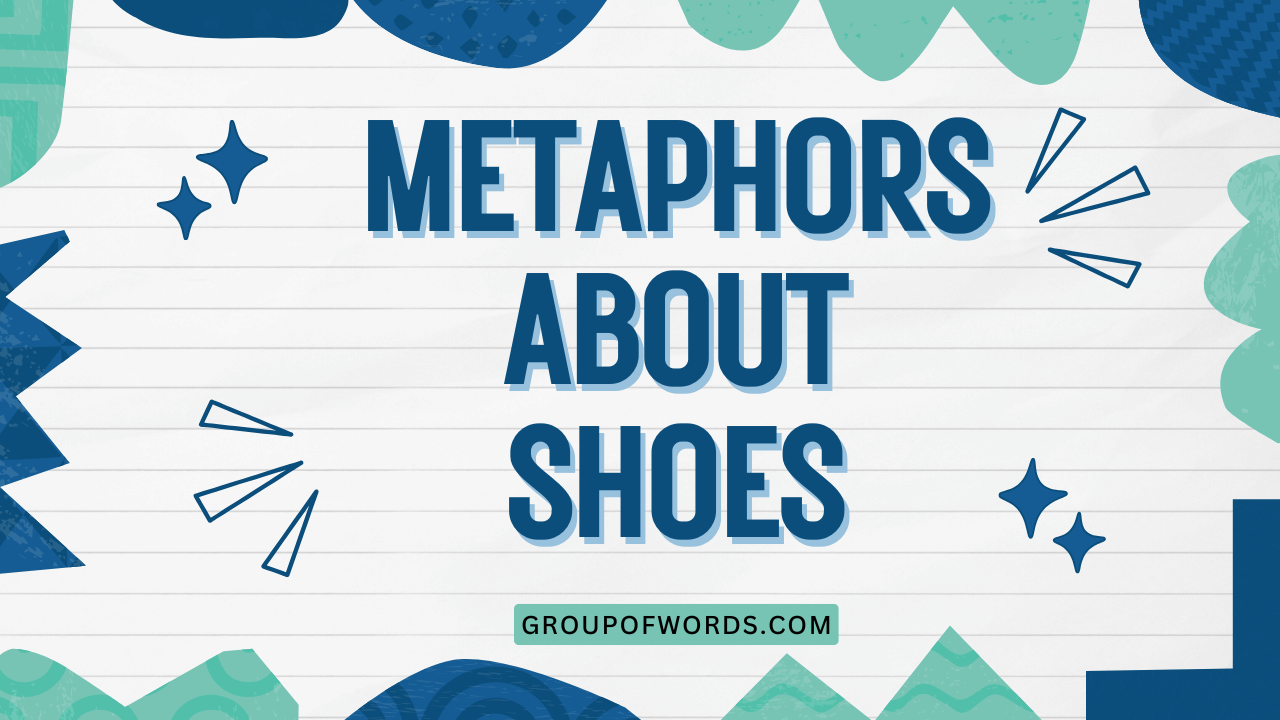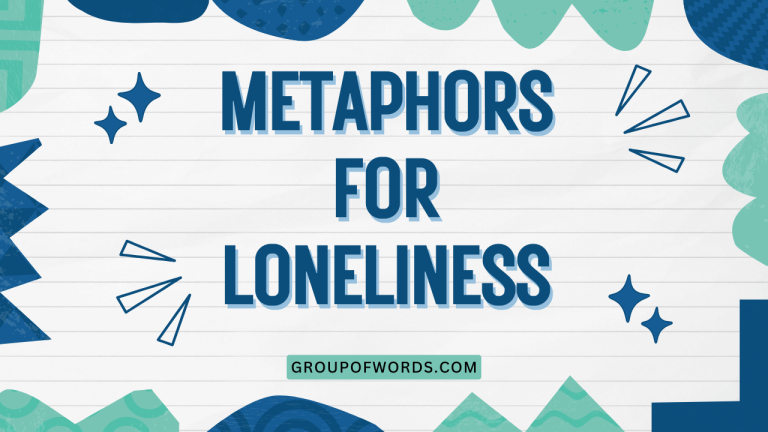Stepping into Figurative Language: Shoe Metaphors Explained
Metaphors are powerful tools in the English language, allowing us to connect seemingly unrelated concepts and create vivid imagery. Shoe metaphors, in particular, offer a rich source of figurative language, drawing on our everyday experiences with footwear to express complex ideas.
Understanding these metaphors enhances comprehension, writing, and overall language proficiency. This article explores the definition, structure, types, and usage of shoe metaphors, providing numerous examples and practice exercises to help learners master this fascinating aspect of English grammar.
Whether you’re an ESL student, a creative writer, or simply an English enthusiast, this guide will equip you with the knowledge to confidently navigate the world of shoe metaphors.
Table of Contents
- Introduction
- Defining Shoe Metaphors
- Structural Breakdown of Shoe Metaphors
- Types and Categories of Shoe Metaphors
- Examples of Shoe Metaphors
- Usage Rules for Shoe Metaphors
- Common Mistakes with Shoe Metaphors
- Practice Exercises
- Advanced Topics in Shoe Metaphors
- Frequently Asked Questions (FAQ)
- Conclusion
Defining Shoe Metaphors
To fully understand shoe metaphors, it’s essential to first grasp the general concept of metaphors and then narrow our focus to how shoes specifically function within this figurative framework.
What is a Metaphor?
A metaphor is a figure of speech that directly compares two unlike things without using “like” or “as.” It asserts that one thing *is* another, suggesting a similarity or shared characteristic between them. Metaphors are used to create vivid imagery, evoke emotions, and provide new perspectives on familiar concepts.
For instance, saying “He is a lion in battle” doesn’t mean he’s literally a lion, but that he possesses lion-like qualities such as bravery and strength. Metaphors enrich language and are crucial for effective communication.
Shoe Metaphors: A Specific Type
Shoe metaphors utilize the characteristics and associations of shoes to represent abstract concepts or experiences. Shoes, being a common and often essential part of our lives, carry symbolic weight.
They can represent journeys, paths, perspectives, challenges, status, and identity. Shoe metaphors leverage these associations to create powerful and relatable images.
A phrase like “walking in someone else’s shoes” doesn’t literally mean putting on their footwear; it signifies understanding their perspective and empathizing with their situation. They are powerful because they can quickly and effectively transmit complex ideas.
Structural Breakdown of Shoe Metaphors
Understanding the structure of a metaphor involves recognizing the source and target domains. In shoe metaphors, shoes always represent the source domain, while the abstract concepts they symbolize constitute the target domain.
Source Domain: Shoes
The source domain in a metaphor is the concrete, familiar concept used to explain the abstract. In shoe metaphors, this is always related to shoes. This includes the physical characteristics of shoes (e.g., size, shape, material), their function (e.g., providing support, protection), and the actions associated with them (e.g., walking, running, wearing). The source domain provides the tangible imagery that makes the metaphor understandable. Thinking about the qualities of different kinds of shoes (boots, sneakers, sandals, etc.) helps to see how they can be used metaphorically.
Target Domain: Abstract Concepts
The target domain is the abstract concept or idea being explained through the metaphor. In shoe metaphors, this could be anything from life experiences and perspectives to challenges and social status. The effectiveness of a shoe metaphor depends on how well the characteristics of the source domain (shoes) map onto the target domain (abstract concept). For example, “filling someone’s shoes” (source domain) represents taking over their responsibilities or role (target domain). The connection should be logical and resonant for the metaphor to be effective. A complex idea can be easily understood when related to a relatable item from daily life.
Types and Categories of Shoe Metaphors
Shoe metaphors can be categorized based on the specific abstract concept they represent. Here are some common categories:
Shoes as a Journey or Life Path
This category uses shoes to represent the journey of life, the path one takes, or significant life events. Shoes, being essential for walking and traveling, naturally lend themselves to this metaphorical representation.
Examples include “walking in someone’s shoes” (experiencing their life) and “stepping into a new pair of shoes” (starting a new chapter).
Shoes Representing Perspective and Empathy
This category focuses on understanding another person’s viewpoint or situation. The phrase “walking in someone else’s shoes” is the quintessential example, emphasizing the importance of empathy and seeing things from another’s perspective.
This use of shoes highlights the idea of experiencing something firsthand to truly understand it.
Shoes Symbolizing Challenges and Obstacles
Difficulties, hurdles, and setbacks can be effectively represented through shoe metaphors. Think of phrases like “shoes that are too big to fill” (an overwhelming challenge) or “shoes that pinch” (minor annoyances or obstacles).
These metaphors draw on the discomfort or difficulty associated with ill-fitting or unsuitable footwear.
Shoes Indicating Status and Identity
Shoes can also be used to symbolize social status, personal identity, or the roles we play in society. Expensive or stylish shoes might represent wealth or status, while worn-out shoes could indicate poverty or hardship.
“Big shoes to fill” can also refer to the high expectations associated with a prestigious position. This category explores the symbolic value attached to different types of footwear.
Examples of Shoe Metaphors
To illustrate the different categories of shoe metaphors, here are several examples organized by their respective themes.
Journey and Life Path Examples
The following table presents examples of shoe metaphors that relate to journeys, life paths, and new beginnings. These metaphors often convey a sense of progress, change, or the challenges encountered along the way.
| Metaphor | Meaning | Example Sentence |
|---|---|---|
| Walking in someone’s shoes | Experiencing their life or situation | Before you judge him, try walking in his shoes for a day. |
| Stepping into a new pair of shoes | Starting a new role or chapter in life | After graduation, she was excited to be stepping into a new pair of shoes as a teacher. |
| Filling someone’s shoes | Taking over their responsibilities or role | It’s going to be tough filling his shoes after he retires. |
| Following in someone’s footsteps | Emulating someone’s actions or career path | He decided to follow in his father’s footsteps and become a doctor. |
| Putting yourself in someone’s shoes | Trying to understand their perspective | To truly understand the conflict, you need to put yourself in their shoes. |
| Knowing where your shoes are going to land | Having a clear plan or direction in life | She liked the stability of knowing where her shoes were going to land each day. |
| Worn out shoes | Feeling tired or depleted from life’s journey | After years of hard work, he felt like a pair of worn out shoes. |
| Walking a mile in someone’s shoes | Gaining a deep understanding of their experiences | You can’t truly understand someone until you’ve walked a mile in their shoes. |
| Losing your shoes | Losing direction or purpose in life | After the setback, he felt like he had lost his shoes and didn’t know where to go. |
| Tight shoes | Feeling constrained or limited in life | He felt like his job was tight shoes, restricting his creativity and growth. |
| Big shoes to fill | Facing a challenge that requires great skill or effort | Taking over the company from her father meant she had big shoes to fill. |
| Walking on eggshells | Being extremely careful in your actions or words | Around the boss, everyone felt like they were walking on eggshells. |
| Finding the right fit | Discovering a compatible path or role in life | She finally found the right fit when she started volunteering at the animal shelter. |
| New shoes on an old foot | Trying something new later in life | Retiring and learning to paint was like putting new shoes on an old foot. |
| Shoes pinching your toes | experiencing little annoyances or discomforts | The constant meetings at work felt like shoes pinching my toes, a constant source of irritation. |
| Walking a rocky path | Facing difficulties and challenges in life | Starting a new business is like walking a rocky path, full of unexpected obstacles. |
| Walking a well-trodden path | Following a conventional or predictable life | He decided to stray from walking a well-trodden path and pursue his passion for art. |
| Shoes that don’t fit | A situation or role that is unsuitable for you | This job feels like shoes that don’t fit; I’m not using my strengths and talents. |
| Dusting off your shoes | Getting over a setback or moving on from a difficult situation | After the failed project, he dusted off his shoes and started planning the next venture. |
| Walking in quicksand | Feeling trapped or overwhelmed by a difficult situation | Dealing with the bureaucracy felt like walking in quicksand, the more I tried, the deeper I sank. |
| Lacing up your shoes | Preparing to start a new task or challenge | After the motivational speech, the team was ready to lace up their shoes and tackle the project with renewed energy. |
| Having to walk on your own two feet | Becoming independent and responsible for yourself | After years of relying on her parents, she finally had to walk on her own two feet when she moved to a new city. |
Perspective and Empathy Examples
This section includes shoe metaphors that highlight the importance of understanding another person’s perspective and developing empathy. These metaphors emphasize the value of seeing the world through someone else’s eyes.
| Metaphor | Meaning | Example Sentence |
|---|---|---|
| Walking a mile in their shoes | Understanding someone’s perspective and experiences | You can’t judge their decisions until you’ve walked a mile in their shoes. |
| Putting yourself in their shoes | Imagining yourself in their position | Try putting yourself in her shoes before criticizing her actions. |
| Seeing things from their shoes | Adopting their viewpoint | It’s important to see things from their shoes to resolve the conflict. |
| Wearing their shoes | Experiencing their life firsthand | He couldn’t understand the challenges until he metaphorically wore their shoes. |
| Borrowing their shoes | Temporarily adopting their perspective | Borrowing their shoes for a moment helped her understand their concerns. |
| Looking down from their shoes | Seeing the world from their social or economic standing | Looking down from their shoes, he couldn’t comprehend the struggles of the working class. |
| Feeling the stones in their shoes | Experiencing their pain and hardships | She started to feel the stones in their shoes once she heard their stories. |
| Treading the same ground in their shoes | Sharing similar experiences and challenges | They began to understand each other better after treading the same ground in their shoes. |
| Seeing the world through their shoes | Understanding their unique worldview | He tried to see the world through her shoes to appreciate her artistic vision. |
| Having to walk in someone else’s shoes | Being forced to understand another’s perspective | The judge wanted him to have to walk in someone else’s shoes before making a decision. |
| Knowing the wear and tear on their shoes | Understanding the impact of their experiences | She realized she didn’t know the wear and tear on their shoes until she heard their life story. |
| Trying on someone else’s shoes | Experimenting with understanding another’s perspective | Trying on someone else’s shoes gave her a better appreciation for their daily struggles. |
| Loosening the laces of their shoes | Easing someone’s burden or stress | By listening and offering support, he helped loosen the laces of their shoes. |
| Walking in shoes that are too small | Experiencing discomfort and limitation in their situation | He felt like he was walking in shoes that were too small, unable to express himself freely. |
| Walking in shoes that are too big | Feeling overwhelmed by the responsibilities of their position | She felt like she was walking in shoes that were too big when she took on the role of CEO. |
| Walking in heavy boots | Bearing a heavy emotional burden | He was walking in heavy boots after the loss of his family member. |
| Walking barefoot | Experiencing vulnerability and exposure | She felt like she was walking barefoot in a world that was quick to judge. |
| Walking in muddy shoes | Dealing with a difficult or complicated situation | He was walking in muddy shoes trying to resolve the conflict between his friends. |
| Walking in polished shoes | Experiencing privilege and ease in life | He had never had to worry about money, walking in polished shoes his entire life. |
| Walking in broken shoes | Experiencing hardship and difficulty | She was walking in broken shoes, facing constant setbacks and challenges. |
| Walking in new shoes | Experiencing a new and unfamiliar situation | He was walking in new shoes when he moved to a foreign country. |
| Walking in comfortable shoes | Feeling at ease and content in their situation | She finally felt like she was walking in comfortable shoes after years of searching for the right career. |
Challenges and Obstacles Examples
This table provides examples of shoe metaphors that represent challenges, obstacles, and difficulties in life. These metaphors often involve discomfort, difficulty, or limitations.
| Metaphor | Meaning | Example Sentence |
|---|---|---|
| Shoes that are too big to fill | An overwhelming challenge or responsibility | Taking over the project felt like shoes that were too big to fill. |
| Shoes that pinch | Minor annoyances or obstacles | The constant interruptions were like shoes that pinch, irritating but not unbearable. |
| Walking through mud | Dealing with a difficult or unpleasant situation | Navigating the bureaucracy was like walking through mud. |
| Shoes wearing thin | Resources or patience running out | His patience was wearing thin after the repeated delays. |
| Tripping over your own shoelaces | Making a mistake due to carelessness or lack of attention | He tripped over his own shoelaces by not proofreading the document. |
| Having the shoe on the other foot | Experiencing a reversal of fortune or roles | Now that he was the boss, the shoe was on the other foot. |
| Walking uphill in heavy shoes | Facing a difficult and tiring challenge | Starting the business felt like walking uphill in heavy shoes. |
| Having to walk through fire | Enduring a severe trial or hardship | She had to walk through fire to prove her innocence. |
| Walking on broken glass | Dealing with a painful and dangerous situation | The negotiations felt like walking on broken glass. |
| Being tied to someone’s shoelaces | Being controlled or restricted by someone else | He felt like he was tied to her shoelaces, unable to make his own decisions. |
| Walking on thin ice | Being in a precarious or risky situation | He knew he was walking on thin ice when he questioned the boss’s decision. |
| Having to walk a tightrope | Balancing competing demands or interests | The manager felt like he had to walk a tightrope between pleasing his boss and supporting his team. |
| Walking a slippery slope | Engaging in actions that could lead to negative consequences | He knew he was walking a slippery slope when he started bending the rules. |
| Being in someone’s shadow | Being overshadowed or dominated by someone else | He felt like he was always in his older brother’s shadow, never able to shine on his own. |
| Walking in circles | Making no progress or getting nowhere | The investigation felt like they were walking in circles, unable to find any new leads. |
| Having to drag your feet | Being reluctant or unwilling to do something | He had to drag his feet to complete the boring task. |
| Having the rug pulled out from under you | Experiencing a sudden and unexpected setback | He felt like he had the rug pulled out from under him when he lost his job. |
| Walking on eggshells around someone | Being extremely careful not to offend or upset someone | Everyone had to walk on eggshells around the boss when he was in a bad mood. |
| Being stuck in the mud | Being unable to make progress or get out of a difficult situation | The project was stuck in the mud due to lack of funding. |
| Kicking stones down the road | Postponing or avoiding a problem | He was just kicking stones down the road by not dealing with the issue directly. |
| Having to climb a mountain | Facing a daunting and challenging task | Completing the project felt like having to climb a mountain. |
| Being weighed down by heavy boots | Feeling burdened by responsibilities or problems | He was weighed down by heavy boots, unable to enjoy life because of his financial problems. |
Status and Identity Examples
This section provides examples of shoe metaphors that relate to social status, personal identity, and the roles we play in society. These metaphors often involve the symbolic value attached to different types of footwear.
| Metaphor | Meaning | Example Sentence |
|---|---|---|
| Big shoes to fill | High expectations or responsibilities associated with a prestigious position | Taking over the CEO role meant she had big shoes to fill. |
| Wearing the crown | Having authority or leadership | As the team leader, he was wearing the crown on this project. |
| Stepping into the limelight | Becoming the center of attention | She stepped into the limelight after winning the award. |
| Being a glove puppet | Being controlled or manipulated by someone else | He felt like a glove puppet, with his boss pulling all the strings. |
| Wearing different hats | Having multiple roles or responsibilities | As a small business owner, she had to wear many different hats. |
| Being in someone’s shadow | Being overshadowed or dominated by someone else | He felt like he was always in his father’s shadow, unable to make a name for himself. |
| Treading on someone’s toes | Offending or encroaching on someone’s territory | He tried not to tread on his colleague’s toes during the presentation. |
| Having feet of clay | Having a hidden weakness or flaw | Despite his success, he had feet of clay, struggling with insecurity. |
| Being a pawn in someone’s game | Being used or manipulated by someone else for their own purposes | He felt like a pawn in their game, sacrificed for their political gain. |
| Wearing a mask | Concealing one’s true feelings or identity | She always wore a mask in public, hiding her true emotions. |
| Being a cog in the machine | Being a small and insignificant part of a larger system | He felt like a cog in the machine, his contributions unnoticed and unappreciated. |
| Standing tall | Displaying confidence and pride | She stood tall despite the criticism. |
| Having a firm footing | Being in a stable and secure position | He finally had a firm footing in his career after years of hard work. |
| Being on shaky ground | Being in an unstable or uncertain position | The company was on shaky ground due to the economic downturn. |
| Being at the foot of the ladder | Being at the beginning of one’s career or journey | He was still at the foot of the ladder, but he was determined to climb to the top. |
| Kicking up your heels | Celebrating or enjoying oneself | They decided to kick up their heels after finishing the project. |
| Putting your best foot forward | Presenting yourself in the best possible light | She always tried to put her best foot forward during job interviews. |
| Being treated like dirt under someone’s feet | Being treated with disrespect and contempt | He felt like he was being treated like dirt under their feet by his superiors. |
| Taking a stand | Defending one’s beliefs or principles | She decided to take a stand against the injustice. |
| Being a shadow of your former self | Being a diminished or weakened version of oneself | After the illness, he was a shadow of his former self. |
| Standing on solid ground | Being in a secure and stable position | After years of uncertainty, she was finally standing on solid ground. |
Usage Rules for Shoe Metaphors
While shoe metaphors can be powerful, using them effectively requires attention to appropriateness, clarity, and originality. Overused or poorly constructed metaphors can detract from your writing or speech.
Appropriateness and Context
Consider the context and audience when using shoe metaphors. A metaphor that resonates in one situation might be inappropriate or confusing in another.
Formal settings may require more subtle or sophisticated metaphors, while informal settings allow for more creative and playful usage. Understanding your audience and the purpose of your communication is crucial for choosing appropriate metaphors.
Clarity and Relevance
A good metaphor should enhance understanding, not obscure it. Ensure that the connection between the shoes (source domain) and the abstract concept (target domain) is clear and logical.
Avoid metaphors that are too obscure or require specialized knowledge to understand. The metaphor should be relevant to the overall message and contribute to the clarity of your communication.
A confusing metaphor is worse than no metaphor at all.
Avoiding Clichés
Overused metaphors, also known as clichés, can lose their impact and make your writing sound unoriginal. While phrases like “walking in someone else’s shoes” are widely understood, try to find fresh and creative ways to express similar ideas.
Consider using less common shoe-related imagery or combining shoe metaphors with other figurative devices to create a unique and memorable effect. Originality can make your writing more engaging and impactful.
Common Mistakes with Shoe Metaphors
Even experienced writers can make mistakes when using metaphors. Here are some common pitfalls to avoid:
Misunderstanding the Metaphor
Incorrectly interpreting or using a shoe metaphor can lead to confusion and miscommunication. Ensure that you fully understand the intended meaning of the metaphor before using it.
If you’re unsure, research its origin and common usage to avoid misrepresenting its meaning. Using a metaphor incorrectly can undermine your credibility and confuse your audience.
Overusing Shoe Metaphors
While shoe metaphors can be effective, using too many in a single piece of writing can become repetitive and distracting. Vary your figurative language and use shoe metaphors sparingly to maximize their impact.
Overuse can make your writing sound forced and unnatural. Balance is key to effective communication.
Creating Mixed Metaphors
A mixed metaphor combines two or more incompatible metaphors, creating a nonsensical or humorous effect. For example, “He was skating on thin ice while climbing the ladder of success” mixes the imagery of skating with climbing, resulting in a confusing and illogical statement.
Avoid mixed metaphors by carefully considering the compatibility of your figurative language. Clarity and consistency are essential for effective communication.
Practice Exercises
Test your understanding of shoe metaphors with these exercises. Each exercise focuses on a different aspect of shoe metaphor usage, from identification to creation and interpretation.
Exercise 1: Identifying Shoe Metaphors
Identify the shoe metaphor in each sentence and explain its meaning.
| Question | Answer |
|---|---|
| 1. She had big shoes to fill when she took over the company. | Metaphor: Big shoes to fill. Meaning: She had significant responsibilities and high expectations to meet. |
| 2. He felt like he was walking through mud trying to get the project done. | Metaphor: Walking through mud. Meaning: He was facing numerous difficulties and obstacles. |
| 3. You can’t judge someone until you’ve walked a mile in their shoes. | Metaphor: Walked a mile in their shoes. Meaning: You can’t understand someone until you’ve experienced their life. |
| 4. After the scandal, his reputation was on shaky ground. | Metaphor: On shaky ground. Meaning: His reputation was unstable and uncertain. |
| 5. She felt like she was always treading on eggshells around her boss. | Metaphor: Treading on eggshells. Meaning: She had to be extremely careful not to upset her boss. |
| 6. He had to dust off his shoes and start again after the failure. | Metaphor: Dust off his shoes. Meaning: He had to recover from a setback and move forward. |
| 7. The new job felt like a perfect fit for her. | Metaphor: Perfect fit. Meaning: The job was well-suited to her skills and interests. |
| 8. He was just kicking stones down the road by avoiding the problem. | Metaphor: Kicking stones down the road. Meaning: He was postponing or avoiding the problem. |
| 9. She was weighed down by heavy boots after the loss. | Metaphor: Weighed down by heavy boots. Meaning: She was burdened by grief and sorrow. |
| 10. He had to learn to stand on his own two feet after his parents passed away. | Metaphor: Stand on his own two feet. Meaning: He had to become independent and self-reliant. |
Exercise 2: Creating Shoe Metaphors
Create a shoe metaphor to describe the following situations.
| Situation | Possible Metaphor | |
|---|---|---|
| 1. Starting a new and challenging project. | Lacing up your boots for a long hike. | |
| 2. Feeling overwhelmed by responsibilities. | Wearing shoes that are too heavy to lift. | |
| 3. Trying to understand a complex issue. | Walking through a maze of tangled shoelaces. | |
| 4. Experiencing a sudden and unexpected success. | Finding a pot of gold at the end of a rainbow while wearing lucky shoes. | |
| 5. Feeling out of place in a new environment. | Wearing formal shoes to a beach party. | |
| 6. Being forced to make a difficult decision. | Walking on a tightrope with worn-out shoes. | |
| 7. Feeling confident and prepared for a challenge. | Wearing | Wearing well-fitted, sturdy boots ready to conquer any terrain. |
| 8. Being taken advantage of or manipulated. | Having someone else walk all over your shoes. | |
| 9. Experiencing a period of great happiness and freedom. | Running barefoot on a sandy beach. | |
| 10. Feeling restricted or confined in a relationship. | Wearing shoes that are several sizes too small. |
Exercise 3: Interpreting Shoe Metaphors
Explain the meaning of the following shoe metaphors in your own words.
| Metaphor | Interpretation |
|---|---|
| 1. “He had to walk through fire to prove his loyalty.” | He had to endure a severe trial or hardship to demonstrate his commitment and faithfulness. |
| 2. “She was just a cog in the machine, her contributions unnoticed.” | She was a small and insignificant part of a larger system, and her efforts were not recognized or appreciated. |
| 3. “The company was on shaky ground after the scandal.” | The company’s stability and reputation were uncertain and at risk due to the negative publicity. |
| 4. “He felt like he was always treading on eggshells around the boss.” | He had to be extremely careful not to offend or upset his boss, as the boss was easily angered or sensitive. |
| 5. “She decided to take a stand against the injustice.” | She chose to defend her beliefs and principles by opposing the unfair treatment or situation. |
| 6. “After years of hard work, he finally had a firm footing in his career.” | After putting in a lot of effort, he achieved a stable and secure position in his profession. |
| 7. “He was just kicking stones down the road by avoiding the problem.” | He was postponing or avoiding the issue instead of addressing it directly, hoping it would resolve itself or go away. |
| 8. “She was weighed down by heavy boots after the loss of her mother.” | She was burdened by grief, sorrow, and the emotional weight of losing her mother. |
| 9. “He had to learn to stand on his own two feet after his parents retired.” | He had to become independent and self-reliant, taking responsibility for his own life and decisions. |
| 10. “The new intern was at the foot of the ladder, eager to prove himself.” | The new intern was at the beginning of his career, with much to learn and prove, and he was enthusiastic about the opportunity to advance. |
Advanced Topics in Shoe Metaphors
For those seeking a deeper understanding, here are some advanced topics related to shoe metaphors.
Cultural Nuances
The meaning and interpretation of shoe metaphors can vary across cultures. Different cultures may associate different symbolic meanings with shoes, based on their customs, traditions, and historical experiences.
For example, in some cultures, taking off one’s shoes is a sign of respect, while in others, it may be seen as impolite. Being aware of these cultural nuances is essential for effective cross-cultural communication.
Researching the cultural context of a metaphor can provide valuable insights into its intended meaning and impact.
Literary Analysis
Shoe metaphors are frequently used in literature to add depth, symbolism, and emotional resonance to narratives. Analyzing the use of shoe metaphors in literary works can reveal deeper themes and character motivations.
Consider how the author uses shoe imagery to convey meaning, create atmosphere, and develop characters. Pay attention to the specific types of shoes mentioned, the actions associated with them, and their symbolic significance within the context of the story.
Literary analysis can uncover the subtle yet powerful ways in which shoe metaphors enrich the reading experience.
Frequently Asked Questions (FAQ)
Here are some frequently asked questions about shoe metaphors.
What is the most common shoe metaphor?
The most common shoe metaphor is “walking in someone else’s shoes,” which means understanding or empathizing with another person’s perspective and experiences.
Why are shoe metaphors so effective?
Shoe metaphors are effective because shoes are a universal and relatable object. Everyone wears shoes, and they carry symbolic weight, representing journeys, status, and identity.
How can I create original shoe metaphors?
To create original shoe metaphors, think about the specific qualities and associations of different types of shoes, and how they might relate to abstract concepts or experiences. Consider using less common shoe-related imagery and combining shoe metaphors with other figurative devices.
What are some common mistakes to avoid when using shoe metaphors?
Common mistakes include misunderstanding the metaphor, overusing shoe metaphors, and creating mixed metaphors. Ensure that your metaphors are clear, relevant, and appropriate for the context and audience.
Can shoe metaphors be used in formal writing?
Yes, shoe metaphors can be used in formal writing, but they should be used judiciously and with careful consideration of the context and audience. Choose metaphors that are subtle, sophisticated, and enhance the clarity and impact of your message.
Conclusion
Shoe metaphors offer a rich and versatile form of figurative language, providing a powerful means of expressing complex ideas and emotions. By understanding the structure, types, and usage rules of shoe metaphors, you can enhance your communication skills and add depth and creativity to your writing and speech.
Whether you’re using them to convey empathy, represent challenges, or symbolize status, shoe metaphors can help you create vivid imagery and connect with your audience on a deeper level. So, step into the world of shoe metaphors and discover the many ways they can enrich your language and your understanding of the world around you.






